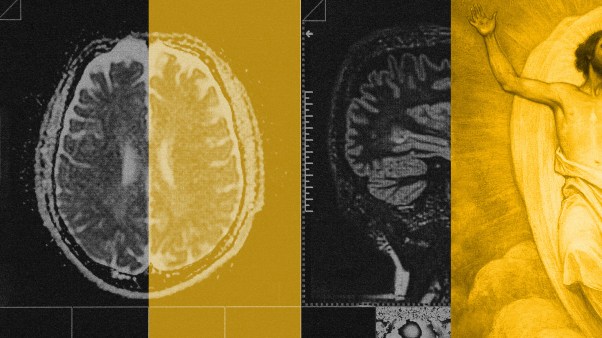Good Friday services were well celebrated within my Afro-Baptist ecclesial tradition. And unlike liturgical settings, where gathered worshipers depart from the service in silence to await the jubilant praise of Easter Sunday, our Good Fridays were often the most energetic services of Holy Week. They were also the zenith of each preaching year and usually featured sermons on Christ’s seven last words.
Many of us have heard a sermon preached on the sixth word, “Tetélestai!,” which is commonly translated into the English phrase “It is finished!” It is one of the few transliterated Greek verbs many believers are familiar with. On that dark day, Jesus shouted this word from the cross shortly before giving up his spirit—conveying the hope of Good Friday.
Tetélestai comes from the Greek verb teleō. In most ancient Greek contexts, the verb means “to finish, accomplish, or complete.” We rightly view this proclamation as Jesus signaling that his death has satisfied the wrath of God fully and forever—that he alone has accomplished the work of atonement, of redemption, and of mediating the way to God.
This statement seems to be the peak of John’s presentation of the salvation story—the time to play the Hammond organ, grab the tambourines, lift holy hands, and sing “Hallelujah,” for Jesus has paid it all!
But there is another moment in John’s Gospel where Jesus states he has finished his work: just one day earlier, on Maundy Thursday—a day that was foreign to me before I stepped into my first pastorate.
Although my childhood church held revival services throughout Holy Week, there was no event held to celebrate the fifth day. And even when I was first introduced to a Holy Thursday service in a church that observed it, I didn’t understand the significance of this day.
That is, until I discovered something in John 17, after the account of the Last Supper and before Jesus is betrayed in Gethsemane.
In between these two significant events, Jesus prays a high priestly prayer that begins with “Father, the hour has come.” And in verse 4, he says, “I glorified you on earth, having accomplished the work that you gave me to do” (ESV). The phrase “having accomplished” is translated from the Greek word teleiōsas, which is not the same verb that gives us tetélestai, although they share similar definitions.
And just like Good Friday often eclipses Maundy Thursday, teleiōsas (from teleioō, or “Little t”) has suffered an identity crisis due to the influence of its better-known big cousin verb, tetélestai (from teleō, or “Big T”).
That’s because many biblical scholars interpret the verb teleiōsas (“having accomplished”) in John 17:4 as pointing toward tetélestai (“It is finished”) in 19:30. They argue that Jesus is speaking prophetically—looking forward to the work he will complete on the cross with certainty, as if he already has accomplished it.
Grammatically, however, the aspect of this verb does not support this interpretation—and by “aspect,” I mean the kind of action, not the time of action, described by the verb.
It would be as if I said, “I made the pound cake” when I had not even begun the process of creaming the butter and sugar. The aspect of “made” must refer to something in the past; it cannot refer to something in the future.
The aspect of teleiōsas points backward, referring to something that has already been completed in the past. It cannot be read as forward-pointing, looking to something that will be achieved in the future. This means that Jesus’ statement in John 17:4 (“having accomplished the work you gave me to do”) is not a foreshadowing of the work of salvation that is “finished” on the cross.
Instead, it is a reference to the completion of another task: making the Father known.
In John’s prologue, the climax of Christ’s coming is found in this verse: “No one has ever seen God, but the one and only Son, who is himself God and is in closest relationship with the Father, has made him known” (John 1:18). Consider Jesus’ response to Philip’s request to see the Father in John 14:9–11:
Jesus answered: ”Don’t you know me, Philip, even after I have been among you such a long time? Anyone who has seen me has seen the Father. How can you say, ‘Show us the Father’? Don’t you believe that I am in the Father, and that the Father is in me? The words I say to you I do not speak on my own authority. Rather, it is the Father, living in me, who is doing his work. Believe me when I say that I am in the Father and the Father is in me; or at least believe on the evidence of the works themselves.
Jesus spent three years revealing the Father to his disciples through his words and his works. As he said previously, “Whatever the Father does the Son also does” (John 5:19). And as he later described salvation, “Now this is eternal life: that they know you, the only true God, and Jesus Christ, whom you have sent” (17:3).
Every one of the signs and wonders, “I am” statements, and discourses mentioned in the Book of John point to Christ’s revelation of the Father as its primary theme. And so, as it turns out, the “Little t” verb in 17:4 is carrying the weight of 16 of the 21 chapters of John’s Gospel.
As Hilary of Poitiers wrote, “The Son reveals by works of power to the ignorance of the heathen and to the foolishness of the world, Him from Whom He is. … The Father is glorified on earth because the work which He had commanded is finished.”
While there is some disagreement with the grammatical interpretation, this view of John 17:4 is argued by late NT scholar Barnabas Lindars and follows the theory of verbal aspect championed by Steve Runge, Mark Dubis, Nicholas Ellis, and Michael Aubrey. The main issue, is again that the popularity of Tetélastai on Good Friday often overshadows the teleiōsas of Maundy Thursday.
And yet it is the accomplished work of Christ proclaimed by “Little t” (“having accomplished”) that makes the work of “Big T” (“It is finished”) even possible. That is, before we can call on Christ for eternal life, we must know the identity of God the Father.
Christ proclaimed the accomplished work of revealing the Father—who is the final object of our salvation, as the one to whom we are being saved in Christ. Jesus came to reveal the Father to those who would trust him for salvation and place their faith in him. And this ultimately points to our hope of knowing the Father wholly and of growing in that inexhaustible knowledge for all eternity.
So, we should shout “Tetélestai” along with fellow believers everywhere on Good Friday, recognizing that redemption is finished in Christ for us. Hallelujah! Amen! But before that, let us remember to also jump for joy and shout “Teleiōsas!” on Maundy Thursday—for the work Christ accomplished in his time on earth by revealing God the Father to us.
Eric C. Redmond is professor of Bible at Moody Bible Institute, associate pastor of preaching and teaching at Calvary Memorial Church in Oak Park, Illinois, and teaching fellow at the C. S. Lewis Institute in Chicago.








